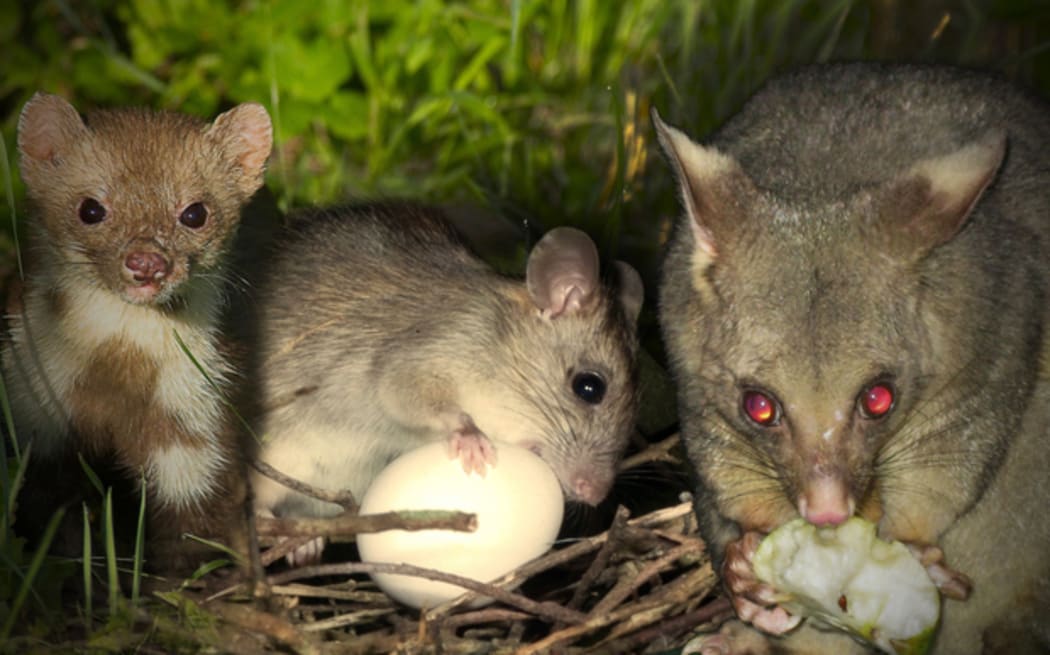Who’s in charge of the conversation?
Kim Hill is joined by bioethicist Josephine Johnston, Dr Andrea Byrom, Kevin Hackwell, and Jan Hania as they explore the opportunities and pitfalls gene editing presents to the control of pests and predators. The final in a series of four public discussions recorded around New Zealand in association with the Royal Society Te Apārangi.

From left to right, a stoat, rat, and possum. Photo: 123RF
The CRISPR gene editing tool enables very precise changes to the genetic composition of its host. While the technology is still very new, it has the potential to be a very powerful tool for the eradication of stoats, rats and possums in New Zealand, with significant benefits to endangered wildlife such as the kakapo.
Inserting a gene for infertility into a rat would normally result in only a 50% chance that the trait would be handed on to the next generation – as the DNA of both parents would be passed on. However, a very new technology called the gene drive would enforce the replication of that desired gene. The result might be the complete eradication of the species, not only in New Zealand, but all round the world.
The invasiveness and comprehensiveness of the gene drive has been tempered by a new tool called the daisy drive. This “daisy chain” system removes the risk that it will drive through a population.
Although the gene drive and daisy drive are still in their infancy, the potential effects of their use with CRISPR editing makes them a subject worth discussing. But among all the talk, who should be leading the conversation?

Kakapo illustrated by J. G. Keulemans, in W.L. Buller's A History of the Birds of New Zealand, 1888. Photo: Wikimedia Commons
Bioethicist Josephine Johnston is very clear that it shouldn’t be the industry, sector or companies involved in the work. Although Dr Andrea Byrom thinks it should definitely not be led by scientists, Johnston thinks there is a really important role at the same time for them.
She cites the example of one of the scientists who invented CRISPR very publicly expressing her concerns about the use of the technology she created. “And she’s standing up there and saying ‘I’m not sure that all the uses of this are actually going to be ok.’”
This message is echoed by Kevin Esvelt, the scientist from MIT Media Lab who has been working on developing the daisy drive for tick-borne diseases in Nantucket and Martha’s Vineyard. He has said “I’m highly sceptical that these global drive systems can be reliably contained and strongly recommend against the use for conservation. Local CRISPR-based systems such as the daisy drive – which my lab are developing – are still early in development.”
According to Kevin Hackwell, a conservation advisor for Forest and Bird, these consequences so far-reaching that those who might potentially benefit from should not be pushing it.
Josephine Johnston agrees. “That’s a lesson also from the GM foods debate/debacle. You can look back at that and see quite a number of mistakes and reasons why that conversation went the way it went around the world.”
But what about calls for public involvement in decision-making? How do you make it informed and rational? Given the misinformation spread about the role of the 1080 poison in predator control, how can you ensure a logical conversation about this more complex area of science?
Opposition isn’t necessarily a sign of irrationality, according to Johnston. There might, she concedes, be a lack of knowledge, but she doesn’t define that as irrationality. She recalls that in the GM foods debate there was a claim that ‘people just don’t understand that the food is actually safe – they’re just anti-science.’
But, she says, those reservations weren’t always unreasonable.
Sometimes what concerned people were the role of companies like Monsanto, or the reduction in biodiversity.
“A lot of the distrust was not irrational. There are really important reasons why, say, indigenous people might be wary of this new way of solving a problem.” In fact, she considers that to be a really rational response to a history of that approach going wrong.
Citing the 1080 debate, Kevin Hackwell adds “You’ve got to take time. I think people are getting much more accepting of 1080 seeing the results how it’s been effective, and the debate has changed significantly in the last ten years.”

Photo: Royal Society
Chaired by Kim Hill, this programme was recorded by RNZ in association with the Royal Society Te Apārangi.
MORE READING
Kevin Esvelt discusses sculpting evolution with Kim Hill
A conservation summit on Predator Free NZ 2050
Editing our genes: medical issues

